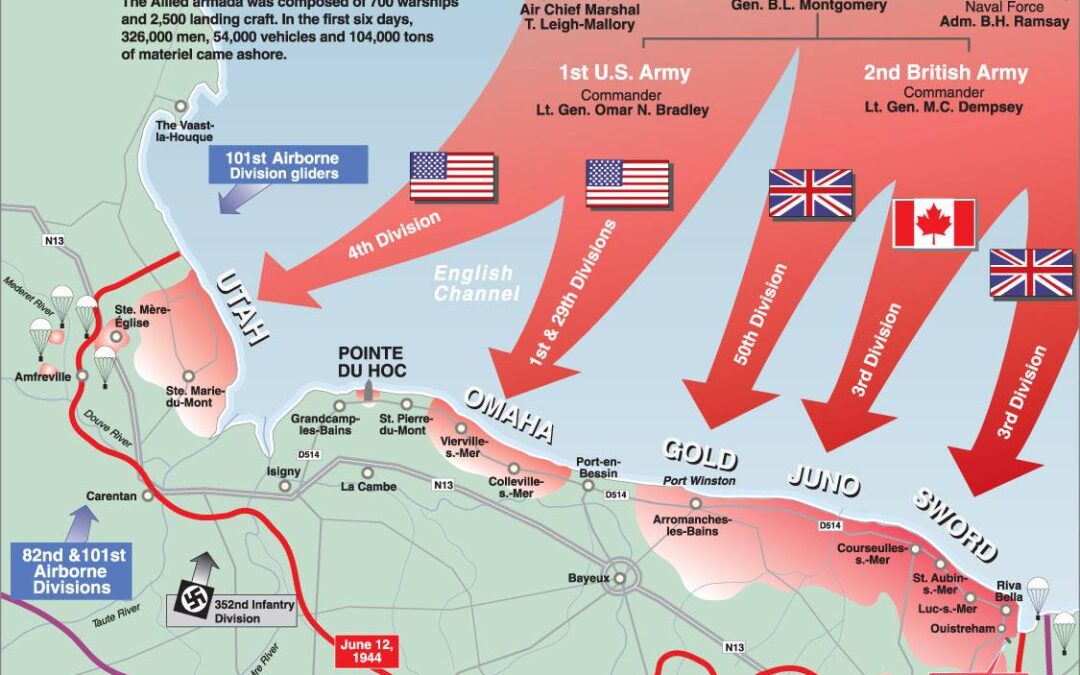The D-Day invasion of Normandy was the greatest assembly of men and machine ever to wage war in history. A calculated gamble with utmost secrecy ultimately paid off, but with a tremendous cost for victory. Image courtesy Stars and Stripes.
Known as the Greatest Generation, American men and boys volunteered to go to war and fight a common enemy. Operation Overlord, commonly known as D-Day, would prove pivotal in victory over NAZI Germany and Adolf Hitler, but that victory came at great cost to American fighting men.
Operation Overlord had been delayed due to bad weather. But, everything had been planned around proper timing of tides, moonlight and the weather for the surprise invasion to work out as expected.
Finally, on June 6, 1944, 156,000 American, British and Canadian soldiers, sailors, airmen, guardsmen and marines were given the go-ahead to begin the invasion of Normandy 79 years ago. That single invasion would be the turning point of the war that would drive from the beaches at Normandy all the way to Berlin and victory almost a year later.
Almost 7,000 ships fought bad weather and raging seas before the men could hit the shore. Once they got there “all hell broken lose” one sergeant recalled.
The term “D-Day” was simply a designation of a launch date for the mission. The exact hour was known as H-Hour. These terms were used to prevent any possibility of enemy intelligence discovering the plan.
The code name for the invasion was Operation Overlord. The sea portion was Operation Neptune. The Allied invasion of Nazi-occupied Europe on D-Day was the largest amphibious invasion in history.
The invasion cracked through Hitler’s western front as Soviet troops made advances in the east. On day one at least 4,400 Allied troops were killed. Many thousands more would suffer the ultimate sacrifice in the ensuing three-month Battle of Normandy before the Allies could march to Paris to liberate the French capital from Nazi occupation.
This one invasion was the result of years of planning to assault northwest France. “Operation Sledgehammer” was the original invasion planned for 1943, but Roosevelt and Churchill determined that attacking North Africa and then moving into Italy would serve the allies better.
“your task will not be an easy one, your enemy is well trained, well equipped and battle hardened. He will fight savagely.” — Gen. Dwight D. Eisenhower
Along with the masses of men and ships were 11,590 aircraft and 867 gliders as air cover. This manpower and machinery were spread over a 50-mile stretch of heavily fortified coastline to fight Nazi Germany occupied French on the beaches of Normandy.
Allied Supreme Commander and US Gen. Dwight D. Eisenhower gave a D-Day ‘order of the day’ speech to inspire the troops prior to landing on the beaches of Normandy. He said the “hopes and prayers of liberty loving people everywhere march with you.” He instructed that the Allied forces would “bring about the destruction of the German war machine” and would bring about “the elimination of the NAZI tyranny over the oppressed peoples of Europe, and security for ourselves in a free world.” He warned that “your task will not be an easy one, your enemy is well trained, well equipped and battle hardened. He will fight savagely.” And indeed the Germans were all those things.
“we will accept nothing less than full victory.” — Gen. Dwight D. Eisenhower
Finally, Eisenhower called the D-Day operation a crusade in which “we will accept nothing less than full victory.” To achieve that victory required the allies not only to fight with all determination and power, but to outmaneuver and trick their NAZI counterparts into believing that an attack would take place at Pas-de-Calais, the closest French coastline to England. Allied troops utilized every deception at hand from spies, saboteurs, double agents, and deceptive radio transmissions, to inflatable rubberized “artillery” and the most admired and feared opponent of the NAZIs General George Patton, to direct enemy attention away from Normandy beaches.
The Normandy beaches were chosen by planners because they lay within range of air cover, and were less heavily defended than the obvious objective of Pas de Calais, the shortest distance between Great Britain and the Continent. Preparation for several months prior to the invasion, several thousand Allied bombers and fighters attacked targets from the Pas de Calais to the north to the French port of Cherbourg to the west and more than a hundred miles inland to isolate the Normandy area of operations and hamper the ability of German commanders to reinforce their forces in Normandy once the invasion began. The plan hampered the arrival of concrete to complete German defensive works along the Normandy coast. Allied airpower greatly impaired NAZI ability to receive troops, equipment and supplies once the invasion began.
H-Hour of D-Day finally arrived for the men to storm the code named beaches of Utah, Omaha, Gold, Juno and Sword. Over the next six days the Allies poured 2,500 landing craft, carrying 326,000 men, 54,000 vehicles and 104,000 tons of material ashore.
And Yes, Guns Were Used!
In fact a variety of guns were used in the D-Day invasion. Among them were, US Rifles: M1903 Springfield, M1 Garand, Carbines, Automatic Rifles: BAR. British Rifles: Lee-Enfield Mark 4 No. 1, Lee-Enfield Mark 5.
US Machine Guns were also used: M1917, M1918/M2, M1919. British: Bren Gun, Vickers Mark I/IV,
US Submachine Guns: M1 Thompson, M3 ‘‘Grease Gun’’, and; British: Sten Gun.
More than 2 million sidearms were issued to US servicemen during WWII. Among them were: the 1911, M1911, M1911A1. British: Browning P-35 Highpower, Webley No. 1 Mark 6.
German D-Day Weapons included: Rifles: Mauser G.98, G.43. Submachine Guns: MP.38/40. Machine Guns: MG.34, MG.42. Pistols: Luger P.08, Walther P.38.
Increased Allied air attacks on German airfields in France during spring of 1944, combined with the growing intensity of the Allied strategic bombing of Germany, caused the German air force high command to pull most of its fighters back to Germany. As a result, the German air force had only about 200 aircraft in Western France on June 6, 1944. By dusk that day, the Allies had launched more than 20,000 sorties throughout Normandy, while the German air force mustered less than 200.
The loss of life and casualties were insanely high. US and Allied men were shot down as they hit the beaches off the landing craft. Equipment and material sank in the higher than expected tides, men drowned due to the weight of their gear. By the end of the day approximately 10,000 men had lost their lives in the invasion. The men had prepared, practiced, and persevered knowing their mission was liberation of France, and Europe, ending at Berlin and Hitler before they could realize total victory.
By the end of the day, more than 100,000 Allied troops had landed and established secure but tenuous beachheads. But, it had come at a tremendous cost of 4,414 men officially dead on that day, along with approximately 8,000 wounded. Of those, 2,501 were US men, and 1,913 were other Allied men killed.
In addition, the NAZIs suffered between 4,000-9,000 men killed, wounded or missing. There were also 200,000 German prisoners of war taken.
Over the next several weeks, those valiant soldiers expanded their mission capturing beaches, cliffs and the surrounding towns. Gen. Patton, who had played the decoy arrived in early July.
This began preparations for Operation Cobra, the breakout from Normandy beginning in late July which would lead men into what we know as the “Battle of the Bulge”. Less than a year later the Allies celebrated the liberation of France and eventually all of Western Europe with the surrender of Nazi Germany on May 7, 1945.
“we fought the wrong enemy” — Gen. George Patton
Our WWII veterans are all older—approaching 100 if not already—and are dying quickly. According to U.S. Department of Veterans Affairs statistics 122,485 WWII veterans are still alive in April 2023. This is down from 167,284 alive in 2022, and approximately 620,000 in 2016, out of the 16 million Americans who served in World War II. Veterans Affairs reports that 4,065 WWII Veterans are still alive from South Carolina.
These veterans answered the call to duty during a time when the United States of America was suddenly, secretly and viciously attacked December 7th, 1941. Take time to remember their sacrifice of time, talent, and selfless devotion defending our country. Many of these valiant warriors still walk among us. Visit with them while you still can.
STATISTICS
• 156,000 troops or paratroopers came ashore on D-Day: 73,000 from the U.S., 83,000 from Great Britain and Canada.
• 195,700 naval personnel were used in Operation Neptune, led by 53,000 U.S. and 113,000 British troops.
• By the end of June 11 (D+5), 326,547 troops, 54,186 vehicles and 104,428 tons of supplies had come ashore.
The armada of Allied ships and aircraft supported the D-Day invasion, and by day’s end, the Allies gained a foot-hold in Continental Europe.
• 11,590 Allied aircraft flew 14,674 sorties on D-Day. Of those, 127 planes were lost. Some 2,395 aircraft and 867 gliders delivered the airborne assault.
• 6,939 vessels were in the armada: 1,213 combat ships; 4,126 landing ships/craft; 736 support ships; 864 merchant ships. The airborne assault into Normandy, as part of the D-Day allied invasion of Europe, was the largest use of airborne troops up to that time.
Commanders
United States – Dwight D. Eisenhower, Omar Bradley; The United Kingdom – Bernard Law Montgomery, Trafford Leigh-Mallory, Arthur Tedder, Miles Dempsey, Bertram Ramsay.
Germany – Erwin Rommel, Gerd von Rundstedt, Friedrich Dollmann
Casualties
Includes all losses: killed, wounded, missing in action and prisoners of war. Like so much of World War II, an accurate casualty count for D-Day may never be known. Recent research by the U.S. National D-Day Memorial Foundation has achieved a much higher figure for Allied soldiers killed in action.
• U.S. casualties on D-Day: 2,499 dead, 3,184 wounded, 1,928 missing, 26 captured.
• Other Allied casualties on D-Day: approximately 2,700 British, 946 Canadians.
• German casualties: 4,000–9,000.
• Total killed, wounded or missing in the Battle of Normandy (June 6-25) for both sides: 425,000.
• French civilians killed in Normandy: 15,000-20,000, mainly from Allied bombing.
• Today, 27 cemeteries hold the remains of more than 110,000 dead, including 9,386 Americans, 17,769 British, 5,002 Canadians, 650 Poles, and tens of thousands of Germans.
War is never a pleasant scene, but tyranny was stopped. Unfortunately, not all of it was stayed. Gen. Patton’s warning that “we fought the wrong enemy” meaning we should have been fighting the Communist Soviet Union, went unheeded. We have paid dearly for that mistake since the war.
“These are the men who took the cliffs. These are the champions who helped free a continent. These are the heroes who helped end a war.” — Ronald Reagan, 40th US President
A toast to the men of WWII! Hurrah for the heroes!





 RSS - Posts
RSS - Posts